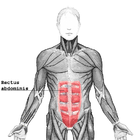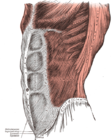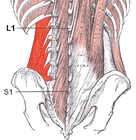User:AerobicFox/Core exercise
Core exercises are practices designed to strengthen and develop target muscles of the midsection including the abdominal muscles, obliques, and muscles of the back. Typical reasons for exercising the core include: improving physical appearance, various athletic benefits, and preventing lower back pain. Often employed by physical therapists
Benefits
[edit]Common benefits cited for practicing core exercises include:
|
|
Evidence
[edit]Anatomy
[edit]
In general practice the "core" refers to the abs, obliques, and muscles of the back. No agreed upon definition, however, for what technically defines the "core" exists with researchers commonly referring to the muscles and connective tissues encircling the spine as belonging to the core. A more specific definition considers the core as consisting of the muscles which act on the thoracolumbar fascia, a large "hoop" of connective tissue which encircles and stabilizes the midsection.[3]
Muscles of the core are generally divided into two groups: deep muscles which are further down and primarily responsible for stability, posture, and balance, and superficial muscles which lie closer to the surface and are primarily responsible for gross movements. The deep muscles of the core are primarily comprised of slow twitch fibers, while the superficial muscles are primarily comprised of fast twitch fibers.[3] Slow twitch fibers are shorter and better suited for maintaining posture, stability, and heavy loads.[3] In this way the deep muscles of the core act to stabilize the spine, maintain balance, and support posture.[3] Conversely the superficial muscles of the core are primarily comprised of fast twitch fibers which are longer and better suited for generating large amounts of torque and full body movements.[3] Together the superficial muscles provide the body with its primary mobility while the deep muscles provide consistent stability and control.[3]
- Deep muscles
- transversus abdominus, one of the core stabilizers
- multifidi
- internal oblique
- deep transversospinalis
- pelvic floor muscles.
- Superficial muscles
- erector spinae
- external oblique
- rectus abdominis, the "6-pack",
- quadratus lumborum
Training methods
[edit]Methods for training will vary person to person depending on physical limitations, motivations, fitness level,
- Common exercises
Crunches, sit-ups Planking
References
[edit]http://well.blogs.nytimes.com/2009/06/17/core-myths/
- Notes
- Footnotes
- Bibliography
- Akuthota, Venu; Ferreiro, Andrea; Moore, Tamara; Fredericson, Michael (2008). "Core Stability Exercise Principles" (PDF). Current Sports Medicine Reports. 7 (1). American College of Sports Medicine: 39–44. doi:10.1097/01.CSMR.0000308663.13278.69. PMID 18296944. Retrieved 26 March 2011.
- Anders, Mark. "New Study Puts the Crunch on Ineffective Ab Exercises" (PDF). acefitness.org. American Council on Exercise. Retrieved 27 March 2011.
- Behm, David G.; Drinkwater, Eric J.; Willardson, Jeffrey M.; Cowley, Patrick M. (2010). "The use of instability to train the core musculature". Applied Physiology, Nutrition & Metabolism. 35 (1). NRC Research Press: 91–108. doi:10.1139/H09-127.
- Behm, David G.; Drinkwater, Eric J.; Willardson, Jeffrey M.; Cowley, Patrick M. (2010). "Canadian Society for Exercise Physiology position stand: The use of instability to train the core in athletic and nonathletic conditioning". Applied Physiology, Nutrition & Metabolism. 35 (1). NRC Research Press: 109–112. doi:10.1139/H09-128. PMID 20130673.
- Fowles, Jonathon R. (2010). "What I always wanted to know about instability training". Applied Physiology, Nutrition & Metabolism. 35 (1). NRC Research Press: 89–90. doi:10.1139/H09-134. PMID 20130671.
- Hibbs, Angela E.; Thompson, Kevin G.; French, Duncan; Wrigley, Allan; Spears, lain (2008). "Optimizing Performance by Improving Core Stability and Core Strength". Sports Medicine. 38 (12). Adis International: 995–1008. doi:10.2165/00007256-200838120-00004. PMID 19026017.
- Karageanes, Steven J. (2004). Principles of manual sports medicine. Lippincott Williams & Wilkins. pp. 510–511. ISBN 978-0781741897. Retrieved 26 March 2011.
- Laskowski, Edward R. M.D. (2009). "Can I use a fitness ball to tone my abs?". mayoclinic.com. Mayo Clinic. Retrieved 26 March 2011.
- Mayo Clinic staff (2009). "Core exercises: 7 reasons to strengthen your core muscles". mayoclinic.com. Mayo Clinic. Retrieved 26 March 2011.
- Mayo Clinic staff (2009). "Slide show: Core exercises". mayoclinic.com. Mayo Clinic. Retrieved 26 March 2011.
- Mayo Clinic staff (2009). "Slide show: Core exercises with a fitness ball". mayoclinic.com. Mayo Clinic. Retrieved 26 March 2011.
- Strongoli, Lisa M.; Gomez, Christopher L.; Coast, Richard J. (2010). "The effect of core exercises on transdiaphragmatic pressure". Journal of Sports Science & Medicine. 9 (2). Academic Search Premier, EBSCOhost: 270–274.
External links
[edit]- Mayo clinic staff (2009). "Slide show: Core exercises". mayoclinic.com. Mayo Clinic. Retrieved 26 March 2011.
- Anders, Mark. "Best Worst Ab Exercises" (PDF). acefitness.org. American Council on Exercise. Retrieved 27 March 2011.




